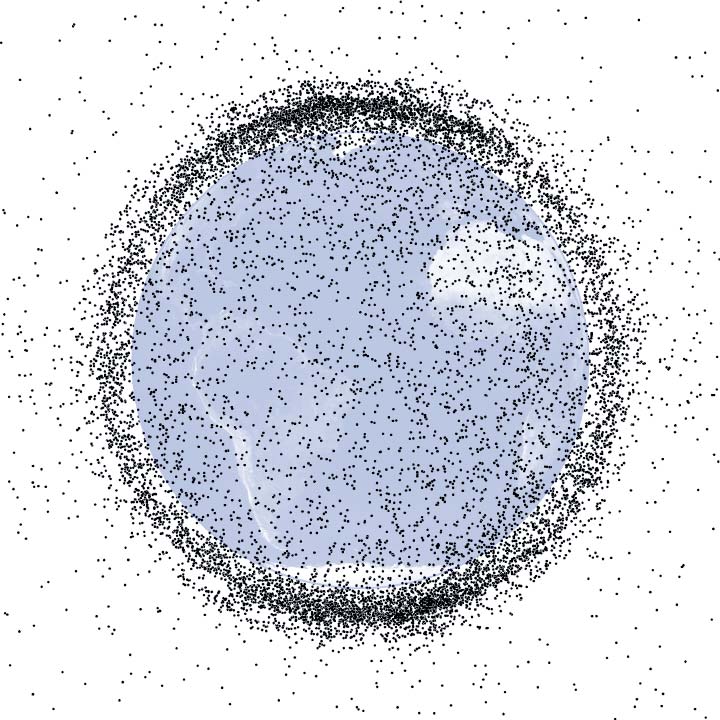Space Junk Falls on Brazilian Village: Reports

A chunk of debris from an old European rocket apparently fell from space Wednesday (Feb. 22) and crashed in a small village in Brazil, according to Brazilian news reports.
The piece of space junk, a spherical object, crashed at around 6 a.m. local time in the village of Anapurus in the state of Maranhão, according to the Brazilian newspaper Jornal Pequeno.
The metal sphere, which measures roughly 3.3 feet (1 meter) across, landed near a house and damaged some trees as it plummeted to the surface, according to the Jornal Pequeno.
The newspaper reported that residents of the village heard a loud bang and saw a bright flash of light before the object made its impact.
Dedicated satellite observers were quick to offer suggestions about what the object could be and where it may have come from. [Photos: Space Junk & Cleanup Ideas]
Ted Molczan, of Toronto, is a respected satellite spotter and a member of a network of devoted amateur skywatchers around the world. On the online satellite-tracking community satobs.org, Molczan noted that the time of the crash and its location strongly indicate that the metallic sphere could be part of a spent European Ariane 44L rocket body.
"Typically, one to two objects are found each year somewhere in the world from re-entries," said Nicholas Johnson, chief scientist for orbital debris at the NASA Johnson Space Center in Houston, Texas.
Get the Space.com Newsletter
Breaking space news, the latest updates on rocket launches, skywatching events and more!
"Last year, more than 100 metric tons of spacecraft and launch vehicles stages fell in uncontrolled reentries," Johnson told SPACE.com. "This amount was higher than recent previous years due to increased solar activity. 2012 might witness an even higher amount of uncontrolled reentry mass."
Johnson spoke earlier this month at the United Nations 49th Session of the Scientific and Technical Subcommittee Committee on the Peaceful Uses of Outer Space in Vienna.
At that UN gathering Johnson noted that nearly 500 satellite reentries occurred during 2011. Of that number, there were 474 that were uncontrolled reentries, along with 25 controlled reentries by 17 spacecraft and 8 rocket bodies.
No accounts of personal injury or significant property damage were reported, Johnson said.
The Brazil crash appears to correlate with re-entry predictions for the Ariane 44L rocket body. According to Space Track, a website managed by the United States Strategic Command, that Ariane 44L rocket body fell to Earth on Feb. 22 at 0909 GMT (or 6:09 a.m. local time in Anapurus).
More photos of the large metal object were posted on a Brazilian blog. Curious townspeople inspected the piece of foreign debris, and even posed for pictures with it, before authorities collected the sphere, reported the Jornal Pequeno.
The crash site in Brazil is located on the predicted re-entry track, suggesting that what fell through the trees in the northeast region of the country was likely part of the old rocket.
The Ariane 44L was used to launch two communications satellites into geostationary orbit on April 17, 1997.
This is also not the first piece of space junk to land in Brazil — in March 2008, a similar spherical object fell to Earth and landed in a rural part of the city Rio Verde.
Earth orbit is littered with derelict pieces of rockets and broken satellites. These shards of space junk pose a lingering threat to other satellites and spacecraft in orbit, and efforts are being made to curtail the amount of trash left in space. Today, more than 22,000 pieces of space debris are tracked in Earth orbit.
Leonard David, SPACE.com's Insider Columnist, contributed to this report. Follow SPACE.com for the latest in space science and exploration news on Twitter @Spacedotcom and on Facebook.
Join our Space Forums to keep talking space on the latest missions, night sky and more! And if you have a news tip, correction or comment, let us know at: community@space.com.

Space.com is the premier source of space exploration, innovation and astronomy news, chronicling (and celebrating) humanity's ongoing expansion across the final frontier. Originally founded in 1999, Space.com is, and always has been, the passion of writers and editors who are space fans and also trained journalists. Our current news team consists of Editor-in-Chief Tariq Malik; Editor Hanneke Weitering, Senior Space Writer Mike Wall; Senior Writer Meghan Bartels; Senior Writer Chelsea Gohd, Senior Writer Tereza Pultarova and Staff Writer Alexander Cox, focusing on e-commerce. Senior Producer Steve Spaleta oversees our space videos, with Diana Whitcroft as our Social Media Editor.









